Republic Day 2022: India celebrates 73rd year of being a Republic – here are top tableaus showcased on country’s greatest extravaganza
As India is celebrating its 73 year of republic and 75th year of independence and the event is beeing celebrated across the country with a lot of pomp and show. We bring you the biggest attractions from respective states in the form of tableaus from these states on Rajpath. Take a look to these!
MEGHALAYA’S 50 YEARS OF STATEHOOD AND ITS TRIBUTE TO WOMEN-LED COOPERATIVE SOCIETIES AND SHGs
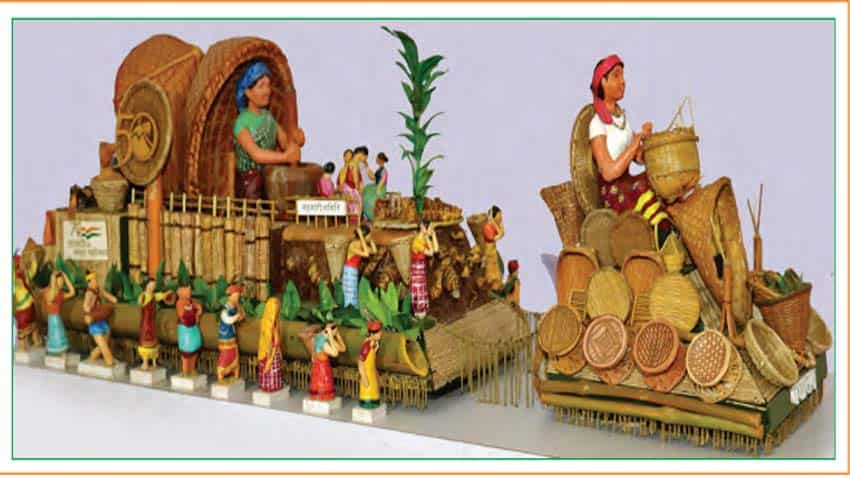
At its 50th year of statehood, Meghalaya through its tableau honors the contribution of women-led Cooperative Societies and Self Help Groups (SHGs) to the State’s economy. The tableau showcases Bamboo & Cane handicrafts and Lakadong Turmeric, the success and popularity of these products are a testimony to the relentless efforts of the women-led Cooperative Societies and SHGs, and their contribution to the State’s economy. Front part of the tableau depicts a woman weaving a bamboo basket and the several bamboo & cane products of Meghalaya. The rear portion of the tableau depicts the traditional farming and processing of Lakadong turmeric.
The entire value-chain is driven by women-led Cooperatives & SHGs, this has been depicted on the tableau. The rear portion also shows the commemorative logo of Meghalaya’s 50th year of statehood.
TRIBAL REVOLUTIONARIES OF GUJARAT
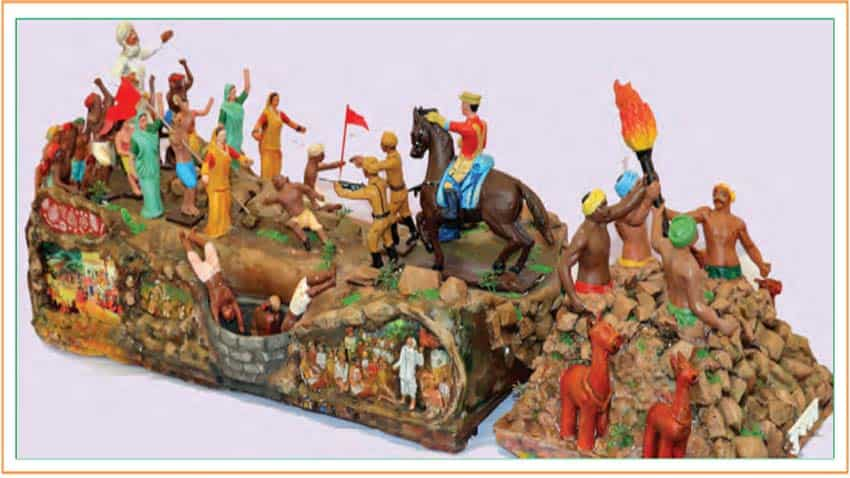
The tableau on the subject ‘Tribal Revolutionaries of Gujarat’ is an untold episode of history. The Britishers had shot to death 1200 tribal freedom-fighters. This tableau is a tribute to their sacrifice. Hundred years ago, on March 7, 1922 Bhil tribes from Paal and Dadhvaav villages (Sabarkantha District, Gujarat) had gathered under the leadership of Shri Motital Tejawat (from a merchant family of Koliyari village, who worked for the tribals’ upliftment and was known as ‘Gandhi’ among them). On that day when he was addressing thousands of tribals to protest against the land revenue system imposed by British and feudal lords, British officer Major H. G. Saturn from Mewad Bhil Corps ordered firing and 1200 innocent tribals were shot dead. Two wells were filled with the martyred tribals. This horrific incident, that occurred just three years after the Jallianwala Bagh incident, was forgotten but India’s Prime Minister Shri Narendra Modi during his days as the Chief Minister of Gujarat glorified it before the world. The front part of the tableau represents the freedom fighting spirit of tribals’ ancestors. The rear portion relives the horrific moment of the massacre by British soldiers atop Jaramara Hills.Tribal artists in their traditional costumes are performing ‘Ger’ dance alongwith the folklore describing that event. Even today, they sing this folklore at auspicious occasions and recount the sacrifices made by their ancestors.
SYMBOLS OF GOAN HERITAGE
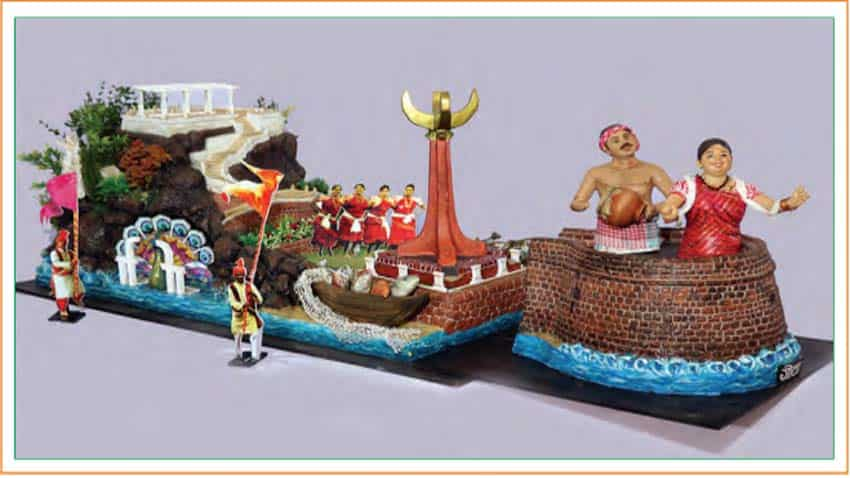
The tableau being presented by Goa state is on the theme “Symbols of Goan heritage” showcasing its various historical and natural attraction. Goa has seen multiple twists and turns in its history and despite these scars, the pearl of the orient has successfully preserved its heritage, culture and natural beauty. In the front portion of tableau, Fort Aguada has been shown which, with a historical legacy of 450 years, overlooking the Arabian Sea, is a massive and marvelous citadel defining the Goan landscape. The fort was built by the Portuguese in 1612 to defend against possible Dutch invasions. During the Goan Liberation Struggle, the fort served as a central jail where freedom fighters were imprisoned before being deported to Lisbon for longer sentences. The Martyrs’ Memorial at Azad Maidan Panaji, shown in the middle of the tableau, is a symbol of selfless sacrifice made by hundreds of Freedom Fighters for the Liberation of Goa. The lotus placed at the top of the memorial symbolizes universal brotherhood.The rear portion of the tableau is showcasing Dona Paula, which is an idyllic rocky tourist attraction that lies at the confluence of rivers Mandovi and Zuari and the Arabian Sea. It is a preferred film shooting spot. Prominent films shot here include Ek Duje Ke Liye, Dil Chahta Hai, Golmal, Singham, and Dear Zindagi. Goa is also the permanent venue for the International Film Festival of India. The Music of Goa is also as diverse and enchanting as the aquatic life in its sea. The dancers seen atop the float represent Kunbi Community, the original inhabitants of Goa. The colorful Shigmo is the most popular spring festival in Goa.
HARYANA NUMBER ONE IN SPORTS

The tableau of Haryana is based on the theme “Haryana number one in sports”. Occupying only 1.3 per cent of the geographical area and accounting for 2.09 per cent of the population of the country, Haryana has brought laurels to India by winning the maximum number of medals out of the total medals won by the country in several national and international sporting events, including the Olympic Games. Out of the 07 medals won by India in Tokyo Olympics-2020, Haryana bagged 04 medals, including the lone gold medal in individual category. The Haryana government awarded cash prizes of Rs 25.40 crore to the sportspersons of the state who participated in the Tokyo Olympics. Similarly, in Paralympics-2020, out of the total 19 medals won by the country, the players of Haryana got 06 medals, including two gold medals in the individual category. Due to the effective policies of the state government, a favourable environment has been created for sports. In the first part of the tableau, the Conch of Lord Krishna has been shown. The chariot carried by horses is a symbol of the “Victory Chariot” of the Mahabharata war. The wrestlers wrestling in the arena above the middle of the tableau reflect the affection towards sports in Haryana. In the rear of the tableau, there are participants and winners in the national and international sports competitions, including the Olympics. This tableau in the form of “Victory Chariot” is a symbol of honour and pride not only for Haryana, but also for the whole country.
PRAGATI KI AUR BADHTA UTTARAKHAND

The Uttarakhand State tableau is inspired by the progressive development projects in the area of connectivity and religious sites. Hence the theme of the tableau is the “Pragati ki Aur Badhta Uttarakhand”. The front porttion of the tableau shows Hemkund Sahib Gurudwara. Hemkund Sahib Gurudwara is situated at an altitude of around 4,329 m, on the bank of the pristine Hemkund Lake. One of the most sacred Sikh shrines, Hemkund Sahib draws thousands of pilgrims every year. Surrounded by snow-capped peaks, the gurudwara’s pictorial natural settings and trek routes, including the Valley of Flowers, make it a popular destination for trekkers and tourists as well. At the front part of the rear portion of the tableau, the Dobra-Chanti Bridge is shown. The 440-meter long Dobra-Chanti suspension bridge is connecting link between Tehri Garhwal district headquarters and Pratap Nagar. Tehri Dam is the highest dam in India and the fourth highest dam in the world. It is shown in the middle part of Tableau. The Badrinath temple is shown in the end part of the tableau. Badrinath temple is one of the four sites in India’s Char Dham pilgrimage. At the side part of the tableau, 12 Thousand Crore Chardham All Weather Road is shown. In the Chardham Highway Project, the pilgrims and tourists have been provided easy transport facilities to the holy Hindu places of Kedarnath, Badrinath, Yamunotri and Gangotri.
ANGLO-ABOR (ADI) WARS
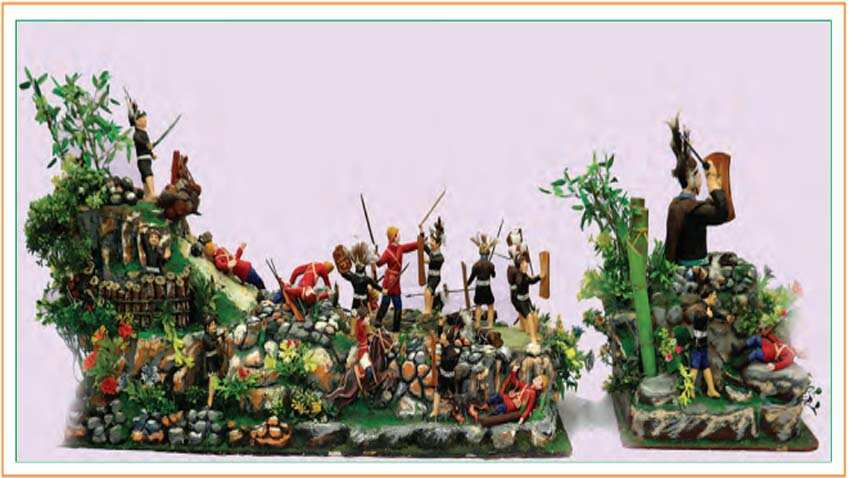
Arunachal Pradesh is the easternmost sentinel frontier of India inhabited by indigenous tribes of various ethnic entities with rich cultural heritage. The theme of the tableau “Anglo-Abor (Adi) Wars” is based on the resistance of the indigenous tribal people of Arunachal Pradesh, particularly the Adis of Siang region (formerly known as Abors by the British), who had bravely fought against the imperial policy of colonial expansion of the erstwhile British rulers in India. The British wanted to penetrate and establish their control over the Adi Land. Their first visit to the Adi land is reported to be in 1826. It had to be cut short to a very brief period as compelled by the indomitable and independent character of the Adis who fought tooth and nail to keep their land independent. This led to series of four military expeditions and ultimately leading to the four Anglo-Abor Wars called ‘Bitbor Mimak’ in 1858, ‘Bongal Mimak’ in 1859, ‘Nijom Mimak’ in 1893-94 and ‘Poju Mimak’ in 1911-12. The British Force had to pull back in the consecutive expeditions / wars because of the unprecedented strong retaliation offered by the Adi warriors. However, many made supreme sacrifice by laying down their lives while displaying absolute bravery and patriotism in the wars. In the front portion of the tableau a bust of an Abor (Adi) warrior and two warriors defending the intruders is depicted. The rear portion depicts an Anglo Abor (Adi) War sequence that was fought between 1858 and 1912.
KARNATAKA: THE CRADLE OF TRADITIONAL HANDICRAFTS

"Karnataka: The cradle of Traditional Handicrafts" is the theme of the tableau of the state. Karnataka is referred to as the Cradle of Traditional Handicrafts as 16 artefacts possess Global Indicator (GI) Tag. From skilfully made pots, carefully sculpted sandalwood miniatures to handwoven sarees, the beauty of handcrafted artisanal objects is its uniqueness.Major crafts of Karnataka are Inlay carvings, Bronze Statues, lacquer ware toys from Channapatna, Kinhal and Bidriware. Terracotta is one of the oldest crafts. Kinhal wood carving is the lacquer ware woodcraft, which was patronized by Vijayanagar Kings. Sandalwood carving is an exquisite art associated with Karnataka, which has a history of more than thousand years. The art of ivory carving is unique to Karnataka. The Karnataka State Handicrafts Development Corporation (KSHDC) has roped in an e-commerce corporate organisation facilitating 55,000 artisans to get better market. Karnataka Tableau depicts Mysore Rosewood ivory Inlay in the front portion. Centre portion showcases eye-catching Bidriware, Kinhala craft, Bronze Statues, Lacquer ware toys from Channapatna, wood carving, pottery. At the rear portion sits Kamaladevi Chattopadhyaya, the mother of Traditional Handicrafts. Karnataka’s own Kamaladevi Chattopadhyaya was a freedom fighter, actress, social activist, art enthusiast rolled-into-one played a vital role in reviving traditional handicrafts, which were on the verge of extinction.
GODHAN NYAY YOJANA: A NEW PATH TO PROSPERITY

The tableau presented here is based on the Godhan Nyay Yojana of Chhattisgarh. The tableau portrays the various ways in which this scheme addresses the multiple global concerns at once by synergizing traditional knowledge and scientific approach to the use of rural resources. The obverse of the tableau depicts rural women in traditional tribal costumes collecting cow dung and taking them to the collection centers in Gauthans for sale. They are wearing hand made clothes and jewellery. The flower pots decorated around them symbolize the cultivation of vegetables and floriculture in gauthans. Downstairs there is a decoration of diyas made of cow dung. These diyas symbolize the self-dependence and self-confidence of women in rural areas. Rear portion the tableau depicts the development of gauthans into Rural Industrial Parks. Women are developing their own enterprises by using new technologies and machines. They are running small industries in the villages. The middle section shows how the goals of environmental protection, organic farming, nutrition, employment and income improvement can be achieved by placing cow at the center of the rural economy. Lastly, the view of rural woman painting symbolizes the development of traditional crafts and arts in the state. The tableau also depicts evolving water management systems, increasing productivity and a happy farmer in a mural style. In this sequence, women of self-help groups are shown preparing various products and vermi compost from cow dung.
CHANGING FACE OF JAMMU & KASHMIR
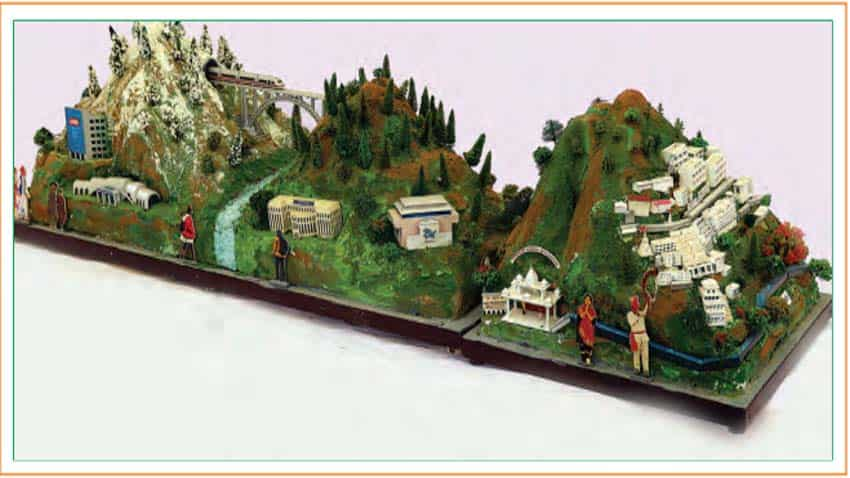
Tableau of the UT Jammu and Kashmir is depicting changing face of Jammu and Kashmir in the backdrop of developmental scenario. Jammu & Kashmir is a newly created Union Territory of Republic of India. It consists of two divisions namely Jammu and Kashmir. Jammu is known as city of temples, while Kashmir Valley is famous for its meadows, lakes, high altitude tourist destinations like Gulmarg and Sonamarg, beautiful Mughal and Tulip Gardens, and ancient religious sites like Martand Sun Temple, Naranag, Mata Kheer Bhawani and Shankaracharya. The front portion of Tableau is showcasing the world famous Mata Vaishno Devi Bhawan located at Katra in the Trikuta Mountains of Jammu Division. It is one of the most visited pilgrimage centres of India. Katra has the best infrastructure to cater the needs of these pilgrims/ tourists. The rear portion of Tableau depicts Indian Institute of Management, Indian Institute of Technology, AIIMS and International Airport being established, which are the some of the exciting developments in UT in recent years. One of the highlights of tableau is the world’s highest railway bridge on Chenab River, which connects Kashmir with rest of the country through train. Further, recently constructed Banihal Qazigund highway tunnel which has been thrown open to the traffic last year is depicted in the backdrop of snow clade mountains of Kashmir. It is one of the longest tunnel in India, with a length of 8.45 km.The tunnel reduces the distance between Srinagar and Jammu by 16 km and travel time from 2 to 3 hours to 16 minutes between Banihal and Qazigund. Tableau is further enriched with traditional folk music of J&K.
ODOP AND KASHI VISHWANATH DHAM
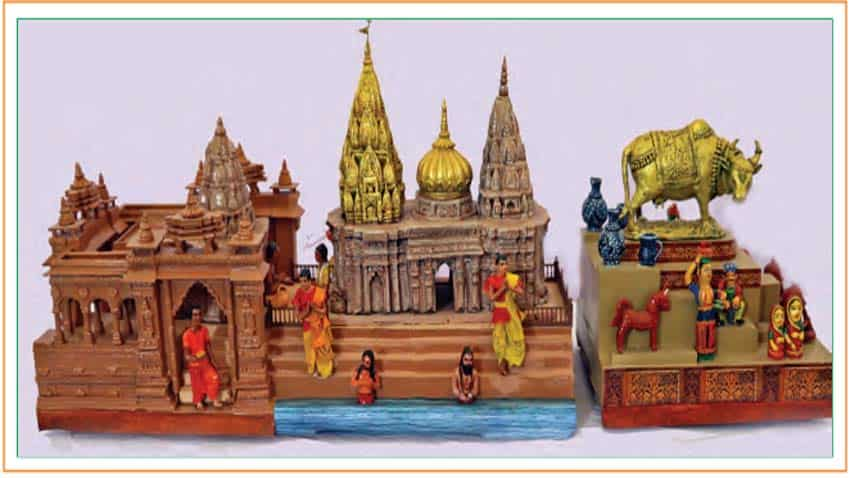
The tableau of Uttar Pradesh is based on the Achievements@75. The tableau shows the achievements achieved through skill development and employment through One District One Product (ODOP) which is based on the new micro, small and medium enterprise policy and industrial development policy of the state government. The development which has taken place in the world famous Kashi Vishwanath corridor is also exhibited. In the front portion of the tableau, the products of each district have been shown which showcases the fast growth of the economy of the state through traditional crafts, weavers and handicrafts products. In central part of the tableau, the culture of sadhus and priests offering argh to the sun at various ghats of Varanasi along with their morning prayers have been shown. In the rear portion of the tableau, the Kashi Vishwanath Dham has been shown showcasing glorious history of world’s ancient city Varanasi. The name of Varanasi city is made from two rivers Varuna and Assi. The Jyotirling of Lord Vishweshwar is revered in Kashi Vishwanath Dham which is situated in the heart of the city and western ghat of Mokshyadani Maa Ganga. The mere sight of this Jyotirlinga leads to spiritual tatvgyan and moksha. The construction of this temple was done by queen of Indore Ahilyabai Holkar in 1780 A.D.
BIODIVERSITY AND STATE BIOSYMBOLS OF MAHARASHTRA
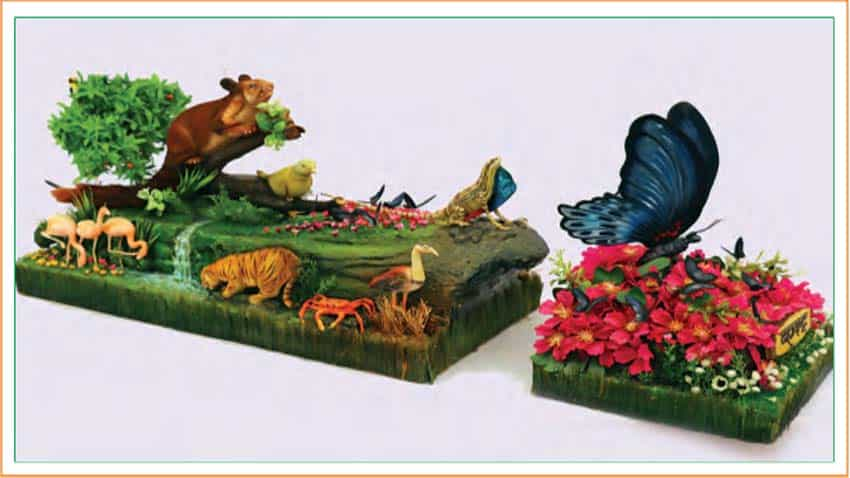
The state of Maharashtra is showcasing, “Biodiversity and Bio-Symbols of the State”, through its tableau. In the tableau, inspired by Achievement@75 under the Azadi ka Amrit Mahotsav, the State’s Five Bio-symbols, pecular environmental sites, special flora and fauna have been depicted. Many efforts are being made to conserve the biodiversity and environment in Maharashtra. Environment is being protected through National Parks, Bird Sanctuaries, Mangrove and Coastal Biodiversity Development Foundation, Tiger Project, Majhi Vasundhara Project, Plastic Ban Act, Biodiversity Heritage Sites, Biodiversity Board etc. Efforts are on to make Maharashtra green through tree plantation. Maharashtra is the first state where plastic is banned. Maharashtra has declared BioSymbols, such as State Animal - Big Squirrel (Shekaru), State Bird - Hariyal, State Tree - Mango Tree, State Flower - Jarul and State Butterfly - Blue Mormon. The front part of the tableau depicts the State butterfly Blue Mormon. About 15 animals and 22 plants/flowers are being shown on the tableau along with two important sites. Apart from the above five State Symbols; Sarada superba found on Kas plateau, Tiger found in Vidarbha, Great Indian Bustard, Flamingo, recently discovered Crab and Fish, Forest Owlet, recently discovered Euphia thosegharensis and Icius tukarami insects, Malabar Hornbill, Indian Vulture etc. have been artistically displayed on the tableau. The plants species like Argyeria, Freria, Habenaria, Utricularia, Adenoon, Acacia, Cynotis, Smithia, Impatiens, Eriocolan, Arisaema, Ceropegia, Vigna, Exacum, Xylocarpus etc. have been shown on the tableau.



